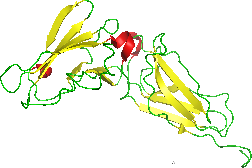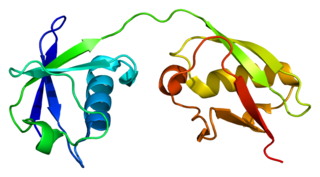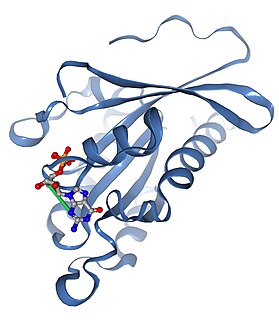
The endoplasmic reticulum (ER) is a type of organelle made up of two subunits – rough endoplasmic reticulum (RER), and smooth endoplasmic reticulum (SER). The endoplasmic reticulum is found in most eukaryotic cells and forms an interconnected network of flattened, membrane-enclosed sacs known as cisternae, and tubular structures in the SER. The membranes of the ER are continuous with the outer nuclear membrane. The endoplasmic reticulum is not found in red blood cells, or spermatozoa.

The endomembrane system is composed of the different membranes that are suspended in the cytoplasm within a eukaryotic cell. These membranes divide the cell into functional and structural compartments, or organelles. In eukaryotes the organelles of the endomembrane system include: the nuclear membrane, the endoplasmic reticulum, the Golgi apparatus, lysosomes, vesicles, endosomes, and plasma (cell) membrane among others. The system is defined more accurately as the set of membranes that form a single functional and developmental unit, either being connected directly, or exchanging material through vesicle transport. Importantly, the endomembrane system does not include the membranes of chloroplasts or mitochondria, but might have evolved from the latter.

The Golgi apparatus, also known as the Golgi complex, Golgi body, or simply the Golgi, is an organelle found in most eukaryotic cells. Part of the endomembrane system in the cytoplasm, it packages proteins into membrane-bound vesicles inside the cell before the vesicles are sent to their destination. It resides at the intersection of the secretory, lysosomal, and endocytic pathways. It is of particular importance in processing proteins for secretion, containing a set of glycosylation enzymes that attach various sugar monomers to proteins as the proteins move through the apparatus.

COPI is a coatomer, a protein complex that coats vesicles transporting proteins from the cis end of the Golgi complex back to the rough endoplasmic reticulum (ER), where they were originally synthesized, and between Golgi compartments. This type of transport is termed as retrograde transport, in contrast to the anterograde transport associated with the COPII protein. The name "COPI" refers to the specific coat protein complex that initiates the budding process on the cis-Golgi membrane. The coat consists of large protein subcomplexes that are made of seven different protein subunits, namely α, β, β', γ, δ, ε and ζ.

C-X-C motif chemokine 10 (CXCL10) also known as Interferon gamma-induced protein 10 (IP-10) or small-inducible cytokine B10 is an 8.7 kDa protein that in humans is encoded by the CXCL10 gene. C-X-C motif chemokine 10 is a small cytokine belonging to the CXC chemokine family.
A vesicular transport protein, or vesicular transporter, is a membrane protein that regulates or facilitates the movement of specific molecules across a vesicle's membrane. As a result, vesicular transporters govern the concentration of molecules within a vesicle.

The interferon-α/β receptor (IFNAR) is a virtually ubiquitous membrane receptor which binds endogenous type I interferon (IFN) cytokines. Endogenous human type I IFNs include many subtypes, such as interferons-α, -β, -ε, -κ, -ω, and -ζ.

Interferon-stimulated gene 15 (ISG15) is a 17 kDA secreted protein that in humans is encoded by the ISG15 gene. The main cellular function of the protein is ISGylation, its covalent addition to cytoplasmic and nuclear proteins, similar to ubiquitination. In addition, ISG15 has anti-viral activity.

Activating transcription factor 6, also known as ATF6, is a protein that, in humans, is encoded by the ATF6 gene and is involved in the unfolded protein response.

Interferon alpha-1/13 is a protein that in humans is encoded by the IFNA1 gene.

KDEL (Lys-Asp-Glu-Leu) endoplasmic reticulum protein retention receptor 1, also known as KDELR1, is a protein which in humans is encoded by the KDELR1 gene.

Rho GTPase-activating protein 32 is a protein that in humans is encoded by the RICS gene. RICS has two known isoforms, RICS that are expressed primarily at neurite growth cones, and at the post synaptic membranes, and PX-RICS which is more widely expressed in the endoplasmic reticulum, Golgi apparatus and endosomes. The only known domain of the RICS is the RhoGAP domain, whilst PX-RICS has an additional Phox homology and SH3 domain.

Oxysterol-binding protein 1 is a protein that in humans is encoded by the OSBP gene.

Interferon-induced guanylate-binding protein 2 is a protein that in humans is encoded by the GBP2 gene. GBP2 is a gene related to the superfamily of large GTPases which can be induced mainly by interferon gamma.
Beta cells are heavily engaged in the synthesis and secretion of insulin. They are therefore particularly sensitive to endoplasmic reticulum (ER) stress and the subsequent unfolded protein response (UPR). Severe or prolonged episodes of ER stress can lead to the death of beta cells, which can contribute to the development of diabetes.

Immunity Related Guanosine Triphosphatases or IRGs are proteins activated as part of an early immune response. IRGs have been described in various mammals but are most well characterized in mice. IRG activation in most cases is induced by an immune response and leads to clearance of certain pathogens.

In molecular biology, the guanylate-binding protein family is a family of GTPases that is induced by interferon (IFN)-gamma. GTPases induced by IFN-gamma are key to the protective immunity against microbial and viral pathogens. These GTPases are classified into three groups: the small 47-KD immunity-related GTPases (IRGs), the Mx proteins, and the large 65- to 67-kd GTPases. Guanylate-binding proteins (GBP) fall into the last class. In humans, there are seven GBPs (hGBP1-7). Structurally, hGBP1 consists of two domains: a compact globular N-terminal domain harbouring the GTPase function, and an alpha-helical finger-like C-terminal domain. Human GBP1 is secreted from cells without the need of a leader peptide, and has been shown to exhibit antiviral activity against Vesicular stomatitis virus and Encephalomyocarditis virus, as well as being able to regulate the inhibition of proliferation and invasion of endothelial cells in response to IFN-gamma.
Viperin, also known as RSAD2, is a multifunctional protein in viral processes, which could be induced in a variety of cell types by different cellular factors, such as type I II and III interferon, DNA and RNA viral proteins, poly and polysaccharide. Recently, it is reported that viperin could be induced in either IFN-dependent or IFN-independent pathway.

Stimulator of interferon genes (STING), also known as transmembrane protein 173 (TMEM173) and MPYS/MITA/ERIS is a protein that in humans is encoded by the TMEM173 gene.

Ras-related protein Rab-2B is a protein that in humans is encoded by the RAB2B gene.














